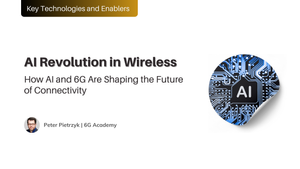The Invisible Force Behind Connectivity
Imagine shouting across a canyon. Your voice is the signal, the air carries it, and your friend on the other side is the receiver. This simple analogy reflects the foundational principles of wireless communication. Radio waves have evolved from this metaphorical shout into a finely tuned, complex system connecting billions of devices worldwide. From enabling the first Morse code signals to supporting today’s global networks, radio waves are the unsung heroes of modern connectivity. The evolution from the first Morse code signals to the upcoming 6G networks showcases how radio waves have transformed from a simple medium of communication into the backbone of a hyper-connected, AI-driven future.
What Are Radio Waves?
Definition and Basics
Radio waves are electromagnetic waves with frequencies from 3 kHz to 300 GHz. They belong to the broader electromagnetic spectrum, which also includes visible light, X-rays, and microwaves.
Picture dropping a pebble into a still pond. The ripples radiate outward, similar to how radio waves propagate through space. The frequency is how often the ripples appear, while the amplitude is the height of each ripple.
Key Properties
- Travel Speed: Radio waves move at the speed of light (299,792 km/s in a vacuum).
- Wavelength and Frequency Relationship: The shorter the wavelength, the higher the frequency, and vice versa.
- Penetration: Lower frequencies (e.g., AM radio) penetrate obstacles better but carry less data compared to higher frequencies like Wi-Fi or 5G.
2. How Do Radio Waves Carry Information?
Modulation: Turning Waves into Messengers
Modulation is the process of encoding data onto a carrier wave. Think of it like hitching a message to a carrier pigeon:
- Amplitude Modulation (AM): Changes the wave’s height to carry information.
- Frequency Modulation (FM): Alters the wave’s frequency to encode data.
- Digital Modulation: Modern methods like QPSK (Quadrature Phase Shift Keying) allow transmitting more data by combining phase and amplitude changes.
A Flashlight Signal
Imagine using a flashlight to send Morse code. Turning it on and off (modulation) sends a message to someone far away, much like how waves are modulated.
A Brief History of Wireless Communication
Wireless communication has evolved dramatically over the last two centuries, transitioning from theoretical concepts to global connectivity systems that underpin modern society. Here’s an in-depth look at the pivotal milestones that shaped this journey.
Pre-1900s: The Dawn of Radio Waves
1864: James Clerk Maxwell’s Groundbreaking Theory
Maxwell’s equations predicted the existence of electromagnetic waves capable of traveling through space, laying the theoretical foundation for wireless communication. He mathematically unified electricity, magnetism, and light into a single theory, asserting that electromagnetic waves could propagate without the need for a physical medium.

1888: Heinrich Hertz Proves Maxwell Right
Hertz experimentally validated Maxwell's theories by generating and detecting electromagnetic waves in his lab. Using a spark-gap transmitter and a simple receiver, Hertz showed that these waves could reflect, refract, and diffract like light waves.
- Significance: Hertz’s work not only confirmed Maxwell's predictions but also demonstrated that electromagnetic waves could be harnessed for practical use.
1900–1950s: Early Wireless Breakthroughs
1901: Marconi and the First Transatlantic Signal
Guglielmo Marconi successfully transmitted a radio signal—the Morse code for the letter “S”—across the Atlantic Ocean. This achievement marked the birth of long-distance wireless communication.
1920: The Rise of Radio Broadcasting
The first commercial radio broadcasts began in the early 1920s, revolutionizing mass communication by bringing news, music, and entertainment into homes.
1940s: Radar Changes the Course of History
Radar (Radio Detection and Ranging) emerged as a game-changing technology during World War II. By transmitting radio waves and analyzing their reflections, radar systems detected the location and movement of enemy aircraft and ships.
- Innovation: Radar’s development spurred advances in high-frequency radio communication and solid-state electronics.



RADAR – The Battle Winner? RAF Museum
1950s–2000s: From Analog to Digital
1956: The First Transatlantic Telephone Cable
While not purely wireless, the first transatlantic telephone cable (TAT-1) used radio wave technology to amplify signals across the ocean. This hybrid approach paved the way for integrated communication systems.
1980s: The Cellular Revolution
The launch of the first-generation (1G) cellular networks marked the beginning of mobile communication. Analog systems like AMPS (Advanced Mobile Phone System) enabled voice calls over wireless networks.
1990s: Digital Communication Takes Off
The introduction of second-generation (2G) networks brought digital communication to mobile phones, enabling text messaging and improved call quality. Simultaneously, Wi-Fi emerged as a standard for local wireless internet connectivity.
2000s–Present: Connectivity Everywhere
2010s: The Rise of 4G
Fourth-generation (4G) networks introduced high-speed mobile broadband, enabling applications like video streaming, online gaming, and IoT devices.
- Transformative Power: Platforms like Netflix, YouTube, and Spotify owe their explosive growth to 4G’s ability to deliver consistent high-speed data.
- Real-World Impact: By 2020, over 60% of the global population had access to 4G networks, bridging the digital divide in many regions.
2020s: The 5G Revolution
The fifth-generation (5G) networks promise unprecedented connectivity with ultra-low latency, high reliability, and support for massive IoT deployments. Key technologies like millimeter waves (mmWave) and massive MIMO (Multiple Input, Multiple Output) systems underpin 5G’s capabilities.
- Applications:
- Smart Cities: Real-time monitoring and management of urban infrastructure.
- Autonomous Vehicles: Reliable, low-latency communication for navigation and safety.
- Remote Healthcare: Real-time video consultations and remote surgeries.
- Looking Forward: As 5G matures, its role as a foundation for emerging technologies like augmented reality (AR), virtual reality (VR), and AI-driven networks will expand.
The Electromagnetic Spectrum: A Wireless Playground
Overview of the Spectrum
The electromagnetic spectrum spans from low-frequency radio waves to high-energy gamma rays. Wireless communication primarily operates in the radio wave and microwave regions.
Imagine a multi-lane highway where each lane represents a different frequency band. Some lanes (low frequencies) accommodate slow but heavy vehicles, while others (high frequencies) handle fast but lightweight ones.
The electromagnetic spectrum is the full range of wave frequencies. Radio waves occupy a segment ideal for wireless communication due to their propagation properties.

Common Radio Wave Applications
| Frequency Band | Frequency Range | Wavelength Range | Key Applications |
|---|---|---|---|
| Extremely Low Frequency (ELF) | <3 kHz | >100 km | Submarine communication, geophysical exploration |
| Very Low Frequency (VLF) | 3–30 kHz | 10–100 km | Navigation, time signals, undersea communication |
| Low Frequency (LF) | 30–300 kHz | 1–10 km | AM longwave radio, maritime navigation |
| Medium Frequency (MF) | 300 kHz–3 MHz | 100 m–1 km | AM radio, maritime and aeronautical communication |
| High Frequency (HF) | 3–30 MHz | 10–100 m | Shortwave radio, international broadcasting, amateur radio |
| Very High Frequency (VHF) | 30–300 MHz | 1–10 m | FM radio, TV broadcasts, marine and aviation communication |
| Ultra High Frequency (UHF) | 300 MHz–3 GHz | 10 cm–1 m | Cellular networks (3G/4G), Wi-Fi, GPS, digital TV |
| Super High Frequency (SHF) | 3–30 GHz | 1–10 cm | 5G networks, satellite communication, radar |
| Extremely High Frequency (EHF) | 30–300 GHz | 1–10 mm | Millimeter-wave 5G/6G, automotive radar, remote sensing |
| Sub-Terahertz (Sub-THz) | 100–300 GHz | 0.1–3 mm | 6G use cases like ultra-high-speed wireless and holographic communication |
| Terahertz (THz) | 300 GHz–3 THz | 0.1–1 mm | Advanced 6G use cases, high-resolution imaging, molecular spectroscopy |
Potential 6G Frequency Use Cases Across Bands
6G will span a broad range of frequencies, leveraging both lower and higher bands to meet diverse demands such as global coverage, ultra-fast data transmission, and real-time intelligence. Unlike previous generations, 6G aims to integrate sub-6 GHz, millimeter-wave, and terahertz bands, ensuring a balance between coverage, capacity, and specialized use cases. This holistic approach allows 6G to serve everything from IoT and rural connectivity to cutting-edge applications like holographic communication and AI-driven networks.

| Frequency Range | 6G Use Cases |
|---|---|
| Below 6 GHz | Wide-area coverage, IoT applications, urban/rural access |
| 3–30 GHz (SHF) | High-capacity communication, mid-range coverage, private networks |
| 30–100 GHz (EHF) | Ultra-reliable low-latency communication (URLLC), V2X (vehicle-to-everything) |
| 100–300 GHz (Sub-THz) | High-speed indoor applications, augmented/virtual reality |
| Above 300 GHz (THz) | Extreme data rates, sensing and imaging, real-time AI-driven systems |
Wireless Systems and Core Components
Wireless communication systems rely on a precise interplay of transmitters, receivers, and antennas to transmit and interpret electromagnetic waves. These components form the backbone of wireless technology, enabling everything from basic radio broadcasts to modern high-speed networks.
Transmitters and Receivers: The Core Functions
- Transmitter: A transmitter converts data—whether voice, video, or digital information—into electromagnetic waves. It encodes this information into the waves through modulation and sends them out via an antenna. The quality of the transmitter often dictates the range and reliability of the signal.
- Receiver: The receiver’s role is to capture these electromagnetic waves and decode them back into usable data. It operates as the counterpart to the transmitter, ensuring the integrity of the signal despite potential interference or attenuation.
Together, transmitters and receivers act as the foundation for wireless communication, ensuring seamless transmission of information across devices and networks.
Antennas: The Interface Between Systems
Antennas serve as the critical interface between transmitters and receivers, facilitating the emission and reception of electromagnetic waves. They are engineered to match specific frequency ranges, ensuring optimal signal strength and clarity.
- Design Evolution: From large, visible structures like satellite dishes to compact internal antennas in smartphones, modern designs prioritize efficiency and integration without compromising performance.
- Advanced Capabilities: Phased-array antennas in modern systems allow for precise beamforming, directing signals with high accuracy to reduce interference and enhance range.
Challenges for Engineers
While the components themselves are highly optimized, the wireless environment introduces significant challenges:
- Signal Attenuation:
As signals travel, their strength diminishes due to distance, obstacles, and atmospheric conditions. Materials like walls, metal, and even water can significantly weaken the signal, making reliable communication over long distances difficult.
- Noise Interference:
External electromagnetic signals, often referred to as "noise," can interfere with the desired signal, reducing clarity and accuracy. This is particularly critical in urban areas where multiple wireless systems operate in close proximity.
Solutions: Enhancing Wireless Performance
- Beamforming:
Beamforming is a sophisticated technique that directs wireless signals toward specific receivers rather than broadcasting in all directions. This approach reduces interference and increases the efficiency of the transmission.
- MIMO (Multiple Input, Multiple Output):
MIMO technology employs multiple antennas at both the transmitter and receiver to handle several data streams simultaneously. This increases capacity and reliability, especially in environments with multi-path propagation (where signals reflect off surfaces like buildings).
Example: Satellite MIMO for Global IoT
Satellites operating in low Earth orbit (LEO) rely on MIMO to deliver connectivity to vast, underserved areas. Take Starlink or OneWeb, for example. Using MIMO, a single satellite communicates with thousands of ground terminals simultaneously.
- Scenario: A farmer in rural Africa, a research ship in the Arctic, and a mountain climber in the Himalayas are all streaming data from the same satellite. MIMO ensures each receives their unique data streams without interference, as if the satellite were "speaking" different languages to each user.
- This capability is critical for global IoT networks, allowing devices like environmental sensors and remote logistics trackers to operate seamlessly across the globe.
Engineering Excellence in Action
The synergy between transmitters, receivers, and antennas, coupled with solutions like beamforming and MIMO, ensures the reliability of wireless systems despite environmental challenges. Engineers continually refine these systems to meet the growing demands of modern applications, from IoT and smart cities to high-speed mobile networks.
By addressing challenges such as attenuation and interference, these core components not only sustain today’s wireless communication but also lay the groundwork for innovations like 6G and beyond.
Applications of Wireless Technology
Wireless technology has become the backbone of modern communication, powering everyday conveniences and enabling breakthroughs across high-tech and critical industries. Its applications are as diverse as its frequency spectrum, ranging from personal devices to global systems that revolutionize industries. Here’s an in-depth look at its impact across various domains.
Everyday Wireless
1. Cellular Networks: The Backbone of Global Connectivity
Cellular networks have evolved dramatically, from basic voice communication in 2G to high-speed data streaming in 4G and 5G. With 6G on the horizon, cellular technology promises even greater advancements.
- Applications: Video streaming, online gaming, telemedicine, smart cities, and autonomous vehicles.
- Emerging Potential (6G): Terahertz-based 6G networks aim to enable real-time holographic communication and immersive virtual experiences.



Motorola DynaTAC in action.
2. Wi-Fi: The Local Area Champion
Wi-Fi is the unsung hero of everyday life, providing wireless internet access in homes, offices, and public spaces. It’s what lets you binge-watch your favorite shows without worrying about cellular data limits.
- Modern Wi-Fi Generations:
- Wi-Fi 5 (802.11ac): Brought gigabit speeds to homes.
- Wi-Fi 6 and 6E (802.11ax): Offers faster speeds, lower latency, and support for dense environments.
- Wi-Fi 7 (coming soon): Aims to deliver unprecedented throughput and multi-gigabit wireless connections.
3. Bluetooth: The Short-Range Workhorse
Bluetooth provides low-power, short-range wireless communication for IoT devices and consumer electronics. It has transformed how we interact with technology, eliminating the need for cables in most personal and professional settings.
- Applications: Wireless headphones, fitness trackers, smart home devices, automotive systems.
- New Frontier: Bluetooth Low Energy (BLE) extends battery life for IoT devices, making it a key enabler for wearable tech and medical devices.
High-Tech Frontiers
1. Quantum Communication: The Future of Security
Wireless quantum communication leverages quantum key distribution (QKD) to create unbreakable encryption. It ensures secure data transfer, even in the face of quantum computing’s decryption capabilities.
- Use Case: Governments and enterprises are exploring quantum satellites to enable ultra-secure wireless networks.
- Emerging Tech: Quantum repeaters are being developed to overcome the range limitations of quantum systems.
- Question to Ponder: What happens when quantum communication becomes mainstream? Could it spell the end of cybercrime as we know it?

2. AI-Driven Networks: Intelligent Resource Allocation
Artificial Intelligence (AI) is revolutionizing wireless networks by optimizing resource allocation in real-time. It’s like having a network administrator working 24/7 to ensure peak performance.
- Applications:
- Predictive maintenance for network hardware.
- Real-time traffic optimization in smart cities.
- AI-based beamforming in 5G and beyond.
3. Satellite IoT: Bridging the Global Connectivity Gap
Satellites are transforming wireless communication by enabling IoT applications in remote and underserved regions. With satellite constellations like Starlink and OneWeb, the vision of global connectivity is becoming a reality.
- Applications: Agriculture (smart farming), environmental monitoring, disaster response, logistics, and shipping.
- Impact: Satellite IoT ensures that devices in the remotest corners of the world can stay connected, enabling transformative solutions in industries like logistics and agriculture.
Aerospace and Defense
1. Radar: The Eyes in the Sky
Radar systems have been a cornerstone of aerospace and defense, providing critical capabilities in detecting objects, measuring their velocity, and tracking their movements.
- Applications: Air traffic control, missile defense systems, weather monitoring.
- Advancements: Modern phased-array radars offer higher resolution and faster response times, critical for real-time decision-making.






2. Military Networks: Secure, Low-Latency Communication
Military networks rely on wireless communication for real-time data sharing, situational awareness, and mission-critical operations. These systems are designed to withstand harsh environments and potential interference.
- Technologies Used:
- SATCOM (Satellite Communication): Provides connectivity in remote battlefields.
- Mesh Networks: Enable resilient, decentralized communication in dynamic scenarios.
- AI-Driven Security: Uses machine learning to detect and neutralize threats in real-time.

Challenges in Wireless Communication and Future Vision
While wireless communication has revolutionized the way we connect and innovate, it faces several critical challenges that must be addressed to ensure continued growth and reliability. From spectrum scarcity to security vulnerabilities and energy demands, engineers and researchers are developing cutting-edge solutions to overcome these hurdles.
1. Spectrum Scarcity: Managing a Crowded Highway
The radio frequency spectrum is finite, yet the demand for it is exploding due to the proliferation of IoT devices, 5G networks, and the looming arrival of 6G. Every new application, from autonomous vehicles to satellite constellations, requires a slice of this already crowded spectrum.
The Problem
- The surge in connected devices creates congestion, especially in popular frequency bands like 2.4 GHz and 5 GHz used by Wi-Fi and Bluetooth.
- Spectrum allocation for industries such as aviation, defense, and telecom often overlaps, leading to potential conflicts.
- Emerging technologies like 6G and satellite IoT will require even more bandwidth, making efficient spectrum management critical.
The Solution: Spectrum Sharing with AI
Artificial Intelligence is emerging as a key player in optimizing spectrum usage. By dynamically reallocating frequencies based on real-time demand, AI ensures efficient utilization of limited resources.
- Example: Dynamic Spectrum Access (DSA) systems allow networks to "borrow" underutilized spectrum temporarily, much like carpool lanes during rush hour.
- Future Potential: AI-driven solutions could enable seamless coexistence of terrestrial, aerial, and satellite networks, ensuring all applications get their fair share of spectrum.

2. Security Concerns: Protecting the Invisible
Wireless systems inherently broadcast signals through the air, making them more vulnerable to interception and attacks compared to wired networks. As more critical infrastructure depends on wireless communication, ensuring security has never been more vital.
The Problem
- Interception: Hackers can exploit unencrypted signals, leading to data theft or eavesdropping.
- Spoofing: Attackers can mimic legitimate devices or networks to deceive users.
- Cyber-Physical Risks: In IoT systems, a single compromised device can provide access to an entire network, creating vulnerabilities in connected homes, factories, or even military systems.
Emerging Solutions
- Quantum Encryption: Leveraging quantum key distribution (QKD), this technology uses the principles of quantum mechanics to create encryption that is theoretically unbreakable.
- AI Anomaly Detection: Machine learning models analyze network behavior in real-time, identifying and mitigating potential threats before they escalate.
Real-World Application
- Defense organizations are testing quantum-encrypted communication channels for battlefield operations, ensuring data security even in adversarial environments.
3. Energy Efficiency: Powering the IoT Revolution
The Internet of Things (IoT) is driving an unprecedented number of devices—each requiring power to operate. However, many IoT applications, such as environmental sensors or wearable devices, operate in remote areas or rely on small batteries, making energy efficiency a critical challenge.
The Problem
- IoT devices need to operate on ultra-low power to extend battery life, especially in inaccessible or remote locations.
- Traditional power sources are neither sustainable nor scalable for billions of IoT devices expected to deploy in the coming years.
The Solution: Energy-Harvesting Sensors
Innovative energy-harvesting technologies are enabling IoT devices to draw power from their environment, eliminating the need for regular battery replacement.
- Solar Harvesting: Sensors collect energy from sunlight, ideal for outdoor IoT applications like smart agriculture.
- Vibration and RF Energy: Devices can harness energy from motion or ambient radio waves, making them self-sustaining.
- Piezoelectric Materials: These materials convert mechanical stress into electricity, perfect for wearable devices powered by body movements.

Future Vision
- As energy harvesting becomes more efficient, we could see IoT devices operating perpetually without batteries, revolutionizing applications like environmental monitoring, smart cities, and healthcare.
6G and Beyond: Meeting the Challenges
The challenges of spectrum scarcity, security, and energy efficiency are not just technical obstacles—they are the defining factors shaping the design and deployment of future wireless networks. Addressing these issues will unlock the full potential of 6G, enabling applications like real-time holography, autonomous transportation, and global connectivity in ways that are secure, sustainable, and accessible.
Not Yet a 6G Academy Free Insider Member?
Make sure you join today and gain access to:
- Exclusive Content: In-depth articles, whitepapers, and insights on 6G advancements and wireless technologies.
- Industry Updates: Stay ahead with the latest trends, breakthroughs, and news shaping the future of wireless communication.
- Learning Opportunities: Get a sneak peek at expert-led courses and resources designed to elevate your knowledge and skills in next-generation networks.
Sign up now and become part of the 6G Academy Free Insider Membership to stay at the forefront of the wireless revolution!













